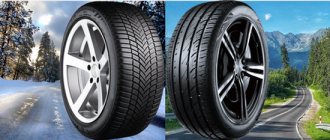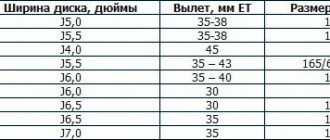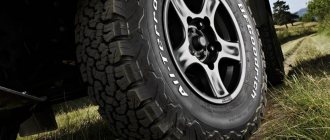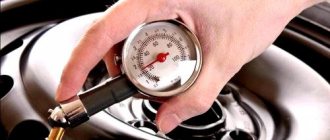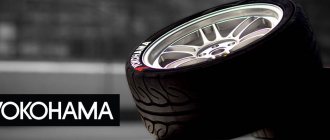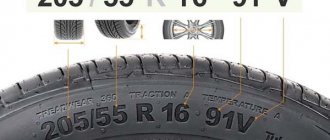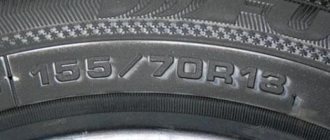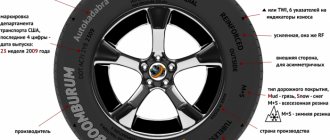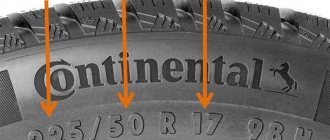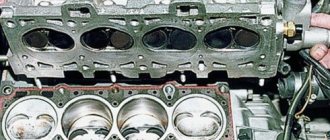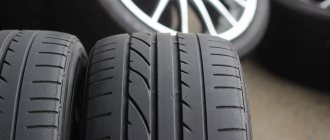Many drivers who until recently were pedestrians ask the same question with the arrival of the winter season: how do winter tires (bottom) differ from summer tires (above). All over the world there is a rule that every car owner must follow: drive on summer tires in the summer, and change to winter tires in the winter.
Summer tires are made of durable rubber that can withstand high temperatures. Unlike winter tires, summer tires have a different pattern, this is due to the fact that they are often used in the rain or for driving on dry roads. It can also be noted. That summer tires are several times wider than their winter counterparts.
Colored lines on the tread
Almost all new tires have multi-colored stripes on the running side of the tires. They are also not of particular interest to the car owner and do not provide him with any useful information. The color coding of tires is intended to simplify their identification in storage areas.
When thousands of tires are stacked in a warehouse, a worker has no way to determine their type and size without seeing the markings located on the sidewall. It is with the help of these colored stripes, arranged in a certain order, that you can clearly identify the type of tire and its size.
For many motorists, changing tires has become a kind of ritual: twice a year they go to the garage or the nearest car service center and change winter wheels to summer ones and vice versa. However, today the market offers universal tire models - the so-called all-season tires. According to manufacturers, they are suitable for both dry asphalt and winter roads. But are they as good as they say in the brochures? We analyzed their characteristics and features and determined what the pros and cons of all-season tires are and whether they are truly suitable for year-round use.
How to buy used tires
Sometimes car enthusiasts buy used tires because... new ones are more expensive. If you still decide to do this:
- Study prices on the car market . Often new budget tires are comparable in cost to used ones.
- Before purchasing tires, send them to a tire shop for diagnostics.
- Please check the reason for the sale , as tires may have hidden defects.
- Do one set of tires have different release dates ? Most likely, they were taken from different car axles or even from different cars. Such tires will wear out at different times, and the set will not last long.
- The history of repairs is important . If the tire is not severely damaged or there were only punctures in the tread, it is enough to have it inspected at a tire shop. But the side cut is a completely different matter. These tires are not suitable for use.
- You should not buy tires if their wear is above 50%.
Pros of all-season tires
- The primary advantage of such all-season tires is their versatility. They are suitable for a significantly wider range of weather conditions than winter or summer.
- It should be noted that there are savings in money and time. Using one set of tires, you can save from 10,000 rubles. on buying summer or winter. In addition, you won’t have to pay 1,000 rubles or more twice a year. for tire fitting services.
- When driving, all-season tires provide sufficient comfort and softness. Even long journeys will not be tiring. This is largely due to the fact that such wheels are softer than summer models.
- When used in winter, all-season tires do not make excessive noise. It does not have spikes or a pronounced aggressive tread pattern, so it remains quite quiet while driving.
- Due to their structural features, the tread of all-season tires is more resistant to wear and abrasion compared to summer or winter tires, for which use in unsuitable weather conditions can be disastrous.
As you can see, all-season tires have a lot of advantages. However, they are largely offset by existing shortcomings.
How to distinguish winter tires from all-season tires
Whatever the conditions of air temperature or the presence of precipitation on the road, the car must in any case clearly maintain contact with the road in winter, summer, and during transition seasons
This is extremely important in order to achieve a normal level of security. The limit of 7°C, which all drivers are guided by when “changing shoes” of a car, can protect themselves from most road troubles associated with the change of seasons
But here one important additional point should be noted: among the tires for some time, summer, winter and all-season tires were distinguished. Today, the Regulations of the Customs Union, which also apply in Russia, no longer recognize such a thing as “all-season tires”. In Europe, to which Ukraine and the Baltic countries are actively reorienting, there is also no such concept. By and large, practical analysis shows that the features of tires that are presented as “all-season” are simply a reduced version of either summer or, more often, winter ones. Thus, the task comes down to understanding very clearly the difference between these basic types, then even on an off-season tire it will be possible to distinguish which type it actually gravitates towards.
Winter tires are softer - just touch them; their rubber content is much higher. When it’s frosty outside, winter tires retain their temperature from friction on the road, as a result of which they become more elastic, resulting in an order of magnitude denser and better grip on the road. But if you use it in the summer, it simply melts, quickly wears off, and even spoils the road surface.
Stiffer summer tires, on the contrary, cool down when driving on hot asphalt and retain the shape and degree of rigidity required for the road. But in the cold, such rubber becomes hard to the point of brittleness, its contact area with the road decreases, the stability of the car also decreases, and the risk of an accident increases if control is lost. A distinctive feature for a winter tire may be the presence of studs on the tread. By definition, there can no longer be any doubt about the seasonality of the tire. But if the winter tire is friction, there are no studs on it. However, the patterns on the tread can tell you here.
Summer tires have a deeper tread pattern. Whereas a similar pattern for the winter version has a characteristic diagonally oriented structure, on which there is a very developed network of channels through which water is drained from the tread. In general, this pattern strongly resembles a herringbone (this is a European type of tire). Or there are many diamond-type figures on the tread, which are placed at a noticeable distance from each other (this is the so-called Scandinavian type).
You might be interested in:
Velcro tire. The operating principle of a friction tire.
The work of friction tires, which now occupy a large part of the winter tire market, from a physics point of view is much more complex and interesting than what the studded versions do. It needs to be pointed out...
Cordiant Polar 2 tire
The Cordiant Polar 2 tire is a winter studded tire with an asymmetric tread pattern. Designed for small and middle class passenger cars. The Cordiant Polar 2 tire was developed for...
Hankook Winter i*cept tire
The Hankook Winter i*cept tire is a new non-studded friction winter tire (Velcro) with a symmetrical tread pattern. The Hankook Winter i*cept tire is designed for use in any winter climate…
Hankook Dynapro i*cept tire
The Hankook Dynapro i*cept tire is a non-studded winter SUV tire with a directional tread pattern. New developments in rubber compounds make it possible to achieve excellent performance in this Hankuk winter tire...
Rubber composition
How to distinguish winter tires from summer tires, what is the difference between these types of tires? An important factor of difference is the composition of the rubber compound. The tire, which is made specifically for winter conditions, is particularly soft. Due to this structure, the wheel successfully holds the car on winter roads and in bad weather. But this quality can fully justify itself only in winter or during slight thaws.
Professionals recommend using summer tires in all other periods. It has a different composition. This tire is more rigid, elastic and wear resistant. In cold weather, summer tires will harden, which is why you should not use them in winter. Naturally, a very soft tire in summer is also not the best choice.
What are all-season tires?
Comparison of tread patterns on all-season (left), summer (center) and winter tires (right).
The very concept of “all-season” should be understood here as universal. That is, it does not have pronounced characteristics that would allow such tires to be classified as summer or winter class.
All-season tires are designed to provide decent handling and driving safety in the widest possible range of weather conditions. That is, an all-season tire occupies a broad middle position between extreme winter and summer road conditions. It is distinguished by a special tread pattern: it is low and assembled from individual blocks and lamellas of small depth.
Initially, all-season tires were developed for American motorists who travel a lot on highways. A uniform, even monotonous ride without significant changes in altitude and road surface characteristics, as well as a year-round mild climate without scorching heat and severe frosts, allow you to drive all year round on the same set of tires. Thus, all-season tires were created specifically for temperate climates, which are not characterized by weather highs and lows. As a rule, the operating temperature of such tires is limited to the range from -7 to +20. They are softer than summer tires, but harder than winter tires.
In addition, most new cars leaving the assembly line are initially equipped with universal tires. This saves the manufacturer and dealers from the headaches associated with seasonality. Otherwise, it would be necessary to constantly “change shoes” of the cars at the exhibition.
Dense profile knurling
If you look closely at the pattern of a winter tire, you will notice several differences from a summer tire:
Photo © : rezulteo
The tread pattern of a winter tire includes many grooves and, accordingly, a larger number of ribs and active corners, which provides the tire with better handling. Photo Bridgestone Blizzak DMV1: rezulteo
Photo © : rezulteo
A winter tire has five times more sipes than a summer tire. Such high siping improves traction by increasing the number of ribs that will interact with the compacted snow surface of the road. Photo Dunlop SP Winter Sport 3D: rezulteo
Photo © : rezulteo
A winter tire has two, three or four wide central grooves (circumferential grooves) to quickly drain water and slush.
- Often the directional tread pattern...
Photo © : rezulteo
Often winter tires have a directional tread pattern, which means they take into account the direction of rotation. They have a V-shaped pattern that allows for better drainage of melting snow and water on the road surface and reduces rolling noise. A directional tire usually has an arrow indicating the direction of rotation. Photo of Goodyear UltraGrip 7+: rezulteo
- ... but sometimes asymmetrical
The right choice of car wheels will allow you to move with comfort and safety. Rubber must strictly correspond to the season, road and temperature conditions. Incorrect use of wheels significantly increases braking distance, wheel service life, and driving efficiency. It is not surprising that manufacturers produce summer and winter tires, and today universal all-season tires are gaining particular popularity. It’s worth figuring out how to distinguish winter tires from summer tires, and to do this you need to study the basic characteristics of the wheels.
Factors that affect tire performance
The most significant factors can be identified:
- The production date is always indicated on the rim.
- Storage conditions. If they are inappropriate, this threatens the formation of microcracks invisible to the eye. They gradually lead to the destruction of rubber.
- Mileage. Both daily driving and prolonged downtime are destructive.
- Pressure. To extend the life of tires, it is necessary to follow the manufacturer's recommendations for pressure levels, otherwise the life will be reduced by 15%.
- Driving faster than 120 km/h reduces the shelf life by half.
- Exceeding the permissible vehicle load. Constant overloads will reduce the tire use time by a third.
- Technical condition of the car. Some faults can lead to increased load on the tires.
Winter
For winter, in addition to the above factors, pressure is important. It should be 0.2 bar higher than recommended
Also in winter you need to carefully monitor the serviceability of the wheel alignment.
Summer
In summer, elevated road temperatures are detrimental to tires.
Therefore, it is important not to delay the timely change of winter tires to summer tires.
How to check the degree of wear
You need to find out whether the tread is worn.
But don't wait for this mark. It is better to use summer tires up to 2-3 mm, winter tires up to 4-6 mm. There are several methods for measurement:
- Visual inspection. Obvious damage will become visible: cuts, cracks. It is worth studying the wear indicator - a protrusion perpendicular to the axis of rotation. If it is equal to the tread height, it is time for replacement.
- Using a caliper or ruler. Measurements must be taken at ten points around the circumference, in the center, along the edges. By summarizing the data, one can judge the suitability.
- Check pressure periodically. When there is a long road ahead, the weight of the car increases significantly; when using a trailer, the pressure must be slightly increased, otherwise the tires will sag and wear out faster under the weight of the car.
- Control suspension geometry. To do this, every month you need to undergo diagnostics of the chassis and steering. Failure to comply may result in uneven grinding.
- Store correctly.
- Don't speed.
- No need to drift.
NOTES FOR MEMORY
At temperatures close to zero (on the “plus” side), the grip properties of summer tires remain quite high. If in the fall you are sure that you will not encounter ice and snow on the road, you don’t have to rush to change your shoes before the onset of frost. The same is true for early spring. And tire manufacturers indicate a temperature of +7°C with a margin in order to be sure to avoid encountering ice.
When replacing summer tires with winter ones, remember: on clean asphalt, the latter always brake worse. As a rule, the better they behave on snow and ice, the less grippy they are on asphalt.
And one more feature of clean asphalt. In frost below -5°C, it, especially smooth, is very treacherous: when braking, it instantly “sweats” in the contact patch, and a thin layer of moisture in the cold immediately turns into an ice crust. It will be especially difficult then on summer tires. So, when frost sets in, we strongly recommend changing your tires to winter ones, even if the roads are completely clear of snow and ice. On roads with rough asphalt, this effect is less pronounced.
And finally, now we can “documentarily” answer the reader’s question: why the same tire sometimes shows different results in different tests. As we can see, they depend not only on the nature of the coating, but also on its temperature.
Winter tires on dry asphalt brake significantly worse than summer tires; when braking from 100 to 5 km/h, the latter take back two car body lengths! Therefore, in the spring, you shouldn’t delay changing your shoes, and in the fall, don’t rush to switch to “winter.”
Not all summer tires are the same: some brake better in hot weather, others better in cool weather.
The best braking properties of most summer tires are at temperatures close to +10°C.
Bridgestone Turanza GR-80
In the heat they show average results, fitting into a crowd of four tires. In cloudy weather, the braking is almost half a meter better. But compared to the others, there is a deterioration; now only Toyo is worse than Bridge. In cool weather, all other tires, with the exception of Kumho, brake better! A cold road is a turning point, on it the braking properties deteriorate: the distance to a stop increased by 1.3 m, and when going “minus” it increased by another 1.4 m. And here “Bridge” turns out to be the last: this is a meter worse, than in the heat.
Tires with traditional temperature orientation. They lose their adhesion properties both with increasing and decreasing temperatures relative to +10°C. At the first cold weather, we recommend changing to winter ones.
Continental ContiPremiumContact 2
On a hot road they brake with a clear advantage. The gap from the nearest opponent is 1.7 m. In cloudy weather, they lose to themselves by 0.9 m, and as a result they “hide” in the middle of the group. On a cool road, gaining back 0.9 m, they return to the “hot” mark of 37.7 m, while remaining in the “middle group”. They don’t like cold asphalt - they give up 1.7 m and fall back to last place. The leader at this temperature, the Pirelli, loses by as much as 3.3 m! In the cold they give up, increasing the braking distance by another 0.9 m, however, they move to penultimate place, overtaking Bridgestone.
KUMHO ecsta XT
In hot weather the braking is average, on par with the Bridge and Pirelli. Cloudy weather has a beneficial effect on traction properties - the braking distance is reduced by 1.3 m, and the place in the middle of the group is maintained. The coolness has a beneficial effect, an improvement of 0.4 m, but the result is the worst of all, although the entire company has very similar indicators. The cold road saves another half a meter, pushing the tires far ahead, since almost everything else here worsens the result. Frost: just ten degrees increases the braking distance by 2.3 m. However, the braking result is comparable to the hottest.
The nature of the change in adhesion properties differs from the traditional one only at temperatures slightly above zero. In other conditions, the dependence is the same as for the tires of the main group. They tolerate cold weather well.
Michelin Energy E3A
In the heat they stop worse than others, trailing the main group by 0.4–1 m, and the leader by almost 3 meters. Cloudy weather brings a "saving" of two meters and a movement to the middle of the group. Coolness reduces the distance by another meter and brings the tires to second place. Michelin doesn't care about the cold weather - the result has not changed. Only Pirelli with the first measurement and Kumho are slightly better. In the cold, increasing the braking distance by only 0.1 m. The behavior compared to the Conti changes exactly the opposite - 37.7 m versus 40.3 on a frozen road, although in the heat it was 40.5 versus 37.7 .
The most cold-resistant tires, not the best performance in the heat, but they can be used in early spring and late autumn. More tolerant of cold than others.
Nokian HAKKA V
On a road warmed by the sun, these tires brake very well, second only to the Continental. True, the gap with him is 1.7 meters. Cloudy weather helps to improve by 0.9 m, maintaining second position. The coolness brings another 0.6 m, but competitors are already getting very close. The cold road changes the situation - it moves the stop away by 0.7 m, although the result turns out to be exactly in the middle. The frost continues what it started - the braking distance increases by 0.8 m. Nevertheless, the obtained result of 39.2 m is very good.
The attitude towards temperature changes is normal. Of the entire company, these are the most stable tires. However, we recommend changing them to winter ones at the first cold weather.
Pirelli Dragon
In the heat, they slow down in the “middle group”, although 39.5 m is the third result. Cloudy weather allows you to win back 1.8 m and move to first place. The gap from the nearest competitor is 0.6 m. Coolness consolidates success. Pirelli is the best here too, and by the same margin. On cold asphalt, unlike the others, these tires have different results in cold and warm conditions. In “cold” they share first place with “Kumho” - 37.5 m, and after several braking in a row they allow you to stop faster than the rest - 36.1 m!
Dual behavior during cold weather: if warmed up, the results are noticeably (one and a half meters) better. The only tires that, at +4°C and below, improve the result after several braking operations performed one after another.
Toyo CF1 PROXES
On a hot road, the tested properties are mediocre - 40.1 m, behind only Michelin. In cloudy weather, braking naturally improves - by 0.7 m. But even then, Toyo is in last place. Cool asphalt allows you to move to the “middle group” - to the mark of 37.7 m; the improvement was 1.7 m. On a cold road, the distance to the stop increased by exactly a meter. Nevertheless, Toyo remains in the middle. The frosty road is harmful, like many others. The indicator worsened by 1.4 m and returned to the level it was at +40°C - 40.1 m.
Tires with traditional temperature orientation. They brake better on cool roads than on those heated by the summer sun. It is worth changing such tires for winter ones at the first cold weather.
Winter tire markings and summer tire markings
To recognize the season, the easiest way is to find the winter markings for m + s (mud and snow) and 3PMSF tires. It should be noted that not every m+s tire is winter. This abbreviation is only a manufacturer's declaration regarding the proposed performance. You may find this designation among others on tires for the US market, where the requirements and standards are slightly different from European ones. M+S is also a common designation for all-season tires. The 3PMSF mark, depicted as a snowflake against a background of three peaks, is a clear indication of the purpose of the model. A tire with this marking was created taking into account the winter conditions that we can encounter in Europe. It will work both during the capricious winter and during a trip to the mountains (although during such a trip it is always worth having chains with you).
The symbol of three peaks with a snowflake is typical for winter tires. All-season tire markings may vary depending on the manufacturer.
The designation of winter and multi-season tires is often reflected in the names of individual models. Manufacturers suggest tires by placing names such as "Winter", "Alpin", "MS" or "4Season" and "All Weather".
All-season models are designed to provide safe driving regardless of conditions, without the need to replace them with seasonal tires. The universal solution is usually chosen by drivers who prefer a relaxed driving style and travel mainly around the city and short distances.
Selection for SUV or crossover
We told you how to distinguish winter tires from summer tires - by the snowflake icon. However, to choose shoes for a non-trivial car, this knowledge may not be enough. When purchasing wheels for a crossover, you should imagine where the car will spend most of its time. If in the city, then standard tires with the designation AW (All Weather or Aqua - improved drainage and increased resistance to aquaplaning) are a good choice.
If the car goes beyond the definition of an SUV and you are planning trips into nature, then it is better to give preference to sets with a developed tire tread, improved lugs and increased cross-country ability. Such kits are designated by the letters AT - All Terrain.
For real off-road vehicles, special tires like Bridgestone Dueler are used, which have proven themselves in combat conditions and have high load resistance and excellent grip. This set is more expensive than the standard one, but its price is justified by its excellent qualities.
What is the difference between winter tires and summer tires?
Experienced motorists know that winter tires are not effective on asphalt. For beginners, winter tires in summer are commonplace. Here it is important to know how to distinguish winter tires from summer tires, and also what is the difference between these types of tires.
Summer tires should provide the most stable coefficient of adhesion to the surface, regardless of various rolling characteristics at high speeds. Summer tires have an asymmetrical pattern - this affects high noise insulation.
To clarify the situation whether it is possible to use winter tires in the summer, it is necessary to evaluate how suitable this tire is for driving in the summer. The tread has “checker marks” with a rather complex terrain. It is thanks to them that a car can drive quite safely on winter snow and ice - this is a method for distinguishing summer tires. Such elements are only found on tires intended for winter. Safety is also enhanced by various grooves, sipes and branches - all of which allow for good grip on snow or ice.
Learning to distinguish
Let's look
Tires for the cold season are distinguished by a carved and deep tread pattern, which can look like the usual “herringbone” or chaotic recesses. Sipes or zigzag cuts on the tread are an advantage of winter tires. It is they, as well as checkered and deep grooves, that provide effective removal of snow and water and increase the coefficient of adhesion on the road. There are two main types of tread patterns for winter:
Scandinavian - the pattern is sparse, the checkers are arranged in a checkerboard pattern and look like diamonds, there is a noticeable significant distance between the elements of the pattern;
European - the pattern is located diagonally, the network of channels is well developed, powerful lugs are located on the periphery of the tread, and there are a large number of thin slots on the surface - lamellas.
Summer tires have shallow tread grooves that are designed to drain water, and the number of sipes is kept to a minimum. There is no micropattern in wheels for summer.
Another criterion for seasonality are thorns. There are no summer studded tires, but winter studded tires should be chosen carefully. The studs are designed for driving on ice, providing good traction where other wheels slip. They should not be placed in two rows on the sides of the tires - this will not reduce the braking distance at all, and the studs themselves will fly out after several trips. High-quality studs require an asymmetrical or serpentine arrangement of the studs.
Let's touch
In addition, the rubber for winter tires is softer and more elastic; it is noticeable to the naked eye for an experienced driver. This is easy to determine even by touch, since there is an order of magnitude more rubber in the rubber mixture, which allows the tires not to freeze at low temperatures. Summer tires, on the contrary, are more elastic - they contain less rubber, since in the heat soft tires “float” and do not hold the road. For safety reasons, summer tires are resistant to wear and high temperatures.
Let's go
During operation, winter tires warm up and therefore do not lose their elasticity and softness. On winter snowy or icy roads, this provides maximum traction and effectively reduces braking distance. Summer tires cool down at speed and become more shaped and hard.
An important quality of rubber that allows you to distinguish between summer and winter tires is the maximum permissible speed. In winter, even on the best roads, it is not recommended to drive faster than 140 km/h; summer tires are more affordable in this matter.
Reading
No matter what, even a novice driver will be able to determine the seasonality of tires by the special designations used by manufacturers. The letters M+S (mud and snow), as well as W (Winter) guarantee comfortable driving on snow and mud; in some cases, MS is a marking for all-season tires. Also, an image of the sun (for summer wheels) and snowflakes (for winter wheels) is applied to the side surface of the wheels.
It is important to know that there is no special letter designation for summer tires
Source rezina.cc
The basis of safe driving is changing the tires on your wheels according to the current season. This requirement is determined by a huge number of factors. But sometimes in the summer you can see a car with winter tires. There are practically no motives for such a solution, it’s just that some car enthusiasts want to easily solve the problem of updating wheels in this way. To understand whether it is possible to operate a car on winter tires in the summer, you need to know how to distinguish winter tires from summer tires, and also understand the properties of both tires.
Rubber compound for tires
The compounds used in summer and winter tires are different because they must operate at different temperatures. Therefore, manufacturers use components such as synthetic and natural rubbers, carbon black, silica or resins and oils in various proportions, thus obtaining rubber with certain properties. Summer tires, which are expected when the thermometer most often starts to show at least 7 ℃, should work both in early spring and in the heat when the asphalt is very hot. It is quite hard and should not soften at the highest temperatures. Winter models are definitely more flexible, so even in cold temperatures they get the job done. Summer tires will harden in winter, which will significantly worsen their adhesion. The car will glide like a skier on a slope, not fully responding to steering inputs. In contrast, colder ones at higher temperatures will be used up much faster - which is uneconomical and at the same time not environmentally friendly.
How to choose?
There is a huge variety of shoes on the market for the new class of vehicle such as SUV. To understand which kits are right for you, you should evaluate the area of use of the machine
If your car spends most of its time on the road, only occasionally getting out of town and driving off the asphalt, then it makes sense to pay attention to road-type tires - with a larger contact patch. It is advisable to take two sets - winter and summer, and not ride all year round on one shoe
If the SUV classification is not just on paper and you have to go off-road, then tires with a universal pattern and an increased profile height are a good choice. This choice will provide the driver with more SUV features without sacrificing comfort.
For experienced off-road drivers, avid hunters and fishermen, special tires with additional lugs, reinforced cords and increased profile height are suitable. Often such models are stamped AT - All Terrain, indicating their off-road orientation.
Additionally, you should pay attention to the speed and maximum load on the wheel. They are located next to the standard size
The speed category is indicated by a Latin letter. For example, the letter T indicates that such a wheel will travel at a speed of 190 km/h. The closer a letter is to the end of the alphabet, the higher the limit. At the moment, the letter Y corresponds to 300 km/h.
One of the most important indicators is the permissible load index. It is adjacent to the category of speed and is expressed in numerical designation. The higher it is, the greater the maximum permissible load on one wheel. It is worth remembering that this parameter is calculated at maximum tire pressure. This indicator is applied closer to the inner edge.
Often on SUV tires you can see the letters EL next to this indicator or the word Reinforced. The presence of such a value indicates a reinforced tire structure and additional layers of cord. If this marking is present, the load capacity index increases by three units.
We received a detailed explanation of the markings of SUV tires. But you should remember that tires should be purchased based on the characteristics of use and seasonality. In this case, you can count on getting the most out of your car and driving pleasure.
Finding characteristics and parameters
Markings on winter tires and summer tires are applied in the same way.
The only differences are in the information and the presence of a snowflake design. The company name and brand of tire should be printed along the outer radius. The following is the wheel dimension taking into account the profile height r. Then the tire's maximum load index is applied, a letter that gives information about the maximum speed. On the inside there is information about the maximum pressure on the tire, the country of manufacture, symbols of compliance with GOST standards, and details of the tire design. For example, there may be colored marks here. The presence of such an indicator as a yellow triangle indicates the lightest part of the rubber. When mounting a new tire on a steel wheel, the mark is aligned with the heaviest spot to make balancing easier. A red dot or triangle on the board indicates the hardest spot. The light alloy material from which the wheels are made is perfect for such sets. It is necessary to align the L mark on the wheel with the red triangle on the tire.
Sometimes there are colored stripes in the tread pattern. This is the internal brand designation of a batch of rubber. It helps you quickly find the right set for your car in the warehouse among different tire options, focusing on the applied color.
Among the additional icons there are indices of heat resistance, wet grip, rain pictograms, encrypted information about a specific manufacturer and batch and rubber composition.
When is it legal to switch to winter tires?
Let's consider paragraph 5.5 of Appendix 8 to the technical regulations of the customs union TR CU 018/2011 “On the safety of wheeled vehicles”:
During the winter period (December, January, February), the operation of vehicles of categories M1 and N1 that are not equipped with winter tires that meet the requirements of paragraph 5.6.3 of this annex is prohibited. Winter tires are installed on all wheels of these vehicles.
A period different from that specified in paragraph one of this paragraph may be established by the legislation of a member state of the Eurasian Economic Union due to climatic and geographical factors characteristic of member states of the Eurasian Economic Union.
So, what can be understood from this paragraph:
- During the summer months (June, July, August) only studded tires are prohibited. This requirement applies to all vehicles.
- During the winter months (December, January, February), only winter tires are permitted. You can put both studded and non-studded tires on your car. The main thing is that they are marked “M+S”, “M&S” or “MS” and the corresponding drawing (in the picture on the left). The requirement applies only to category B vehicles (M1 cars and N1 trucks). The restriction does not apply to other vehicles from November 11, 2022.
- The terms of the ban on exploitation can only be increased by the legislative authority of any level (federal, regional) and cannot be reduced. Those. In your region, for example, the use of studded tires may be prohibited from May to September. At the same time, regional authorities cannot reduce the period of the ban, i.e. From June to August, cars in all regions must not use studs.
Thus, there are the following intervals for using car tires:
- Summer tires (without M+S marking, etc.) can be used from March to November.
- Winter studded tires (marked M+S, etc.) can be used from September to May.
- Winter studless tires (marked M+S, etc.) can be used all year round.
Let's look at a table with periods of possible tire use throughout the year:
| Summer | Winter studded | Winter studless | |
| Winter (December – February) | + | + | |
| Spring (March – May) | + | + | + |
| Summer (June – August) | + | + | |
| Autumn (September – November) | + | + | + |
Thus, if you have summer tires (without markings) and winter studded tires, then you must replace them during the fall, i.e. from September to November.
The tire replacement should be done during the spring, i.e. from March to May.
Summer tires and winter tires
Tires are designed to perform under specific conditions, both in terms of weather and the vehicles with which they are homologated. One product is designed for city cars and another for sports cars or trucks. However, what is important is that each tire must provide the driver with safety, since it is the only element that connects the car with the road. For this reason, differences in seasonal patterns can be seen in three areas:
- applied mixture
- tread pattern
- performance .
Which tires are better, studded or not?
Before choosing this or that rubber, you must clearly understand in what environment and place you are going to use it. Tests have shown that, in general, the braking efficiency of both types is the same, but there are situations when one or another tire behaves worse or, on the contrary, better.
So, here's what the tests showed:
Studded tires
It behaves perfectly on roads with ice and with a mess of snow under which there is a crust of ice. In this case, the air temperature should not be lower than -15 °C. If you get on ice at lower temperatures, then on such rubber you will feel like you are on skates; the spikes will not cling to the hard surface.
Velcro
Accordingly, on an icy road down to -15, covered with loose snow, this tire is inferior to studded tires, but on a cleaned road at lower temperatures it wins. The braking distance will be shorter.
Conclusion: if you live in a city where the roads are cleared, then it is better to choose Velcro; if you often travel outside the city, where the roads are covered with snow in winter, your choice is studded tires.
On snow, both tires behave the same, but studded tires are much noisier! And also in some countries, studded tires are completely prohibited for use. And most importantly, you should not save, and if it wears out, it is better to buy a new one from a well-known manufacturer - after all, your and someone else’s life depends on it!
Many readers of my blog often ask me what is the difference between summer tires and winter tires, except for studs and tread. And why can’t you drive on winter tires in the summer and summer tires in the winter? I decided to reveal all these questions in the next article. For those interested, read on...
At first glance, they can be distinguished purely visually. The winter version has a coarser and deeper tread, as well as a completely different pattern, which, as a rule, is not similar to the pattern on the summer model, it also has studs for good grip on winter roads, for example with ice (by the way, there are now a lot of types of them, read). But the difference lies not only in the design and the presence of spikes, here guys everything is much more complicated.
Summer tires are made from a specific rubber compound that can withstand very high temperatures above zero. Asphalt is quite hot in summer, and the wheels must withstand these temperatures during acceleration and braking. It should be noted that it is much tougher than winter. But as the temperature drops below zero, summer tires become completely inelastic, and a car on such wheels can easily skid. A simple example: place a regular eraser in the snow in the cold and leave it for two to three hours. Then take an eraser and try to bend it. The eraser will lose its elasticity and break easily. The same thing happens with the summer version in the cold, it becomes dull and wears out very quickly, and it’s simply not possible to drive on such tires!
Remember!
Summer tire - must be used until the temperature is below zero, that is, minus one, we change it immediately, even if there is no snow.
The winter version also has a certain composition. Only the focus here is completely different. Winter does not please us with warm days; the thermometer is almost always in the sub-zero zone, sometimes even exceeding -35. And the task is to remain elastic in such frosts and provide maximum grip on the road. The difference between winter tires and their opponents is their softness, that is, they are much softer than summer tires. And the high tread also fights snow and ice. Therefore, it looks much more massive, with a high tread. You just need something to cling and dig up the snow. However, it is absolutely not adapted to above-zero temperatures, and especially to rain. A car with spikes in puddles is like a “cow on ice”; it is difficult to control. And hot asphalt quickly wears out soft winter tires. Try to heat the same eraser and run it across the asphalt; it will leave a trail of small pieces of rubber behind it; when heated, it collapses very quickly. About the same thing happens with a tire; its soft base literally melts in the heat, on hot asphalt.
Remember!
This type should be used up to the plus mark. If the snow has melted and it’s already plus one at night, then it’s better to change it.
Sometimes it may seem, especially when driving on asphalt, that winter tires are much harder than summer tires, but this is not the case. The hum that occurs when the car is moving is caused by the studs and high tread, not by the harshness.
Now guys, this is a very useful comparative video, although it’s in English, but you can catch the main points, let’s take a look.
Tread
Although we cannot judge the composition of the compound using our eyes, the appearance of the tread tells us a lot. Its type determines a number of parameters - from grip on different surfaces, to tire volume and rolling resistance.
Summer tires are designed to run best on dry surfaces and provide the most traction when the road is covered in water. In order for tires to do this, the tread on summer models is the smoothest available. It is divided into large blocks, allowing most of the surface to be in contact with the ground. The ribs are separated by wide grooves that are responsible for removing water from the front of the tire, reducing the risk of skidding caused by hydroplaning.
As is typical for winter tires, the tread is deeper and the pattern is more complex. You may notice numerous slits and cuts, which, although unobtrusive, are indispensable in difficult conditions. They are responsible for the release of water, snow and dirt, which makes driving easier and the braking distance becomes as short as possible.
All-season tires: designations, markings
There are also universal tires that can be used at any time of the year. The designation of all-season tires depends on their operating conditions and may have the following abbreviations:
- “AS” (All Season, Any Season) – all seasons;
- “R+W” (Road + Winter) – all-season for cold regions;
- “AW” (Any Weather) – all-season for any weather.
Additionally, the designation of all-season tires often contains the words “Aqua”, “Water”, “Aquacontact”, “Rain” or an umbrella design. This means that rubber is able to effectively remove water from the plane of contact with the road surface, which significantly reduces the likelihood of hydroplaning. These tires are called rain tires.
But do not forget that all-season tires are a rather relative concept, and it is strongly not recommended to use them in extreme conditions.
By tread
Products for winter have a pronounced pattern with relief details, deep channels, and numerous slats. They serve to remove snow and water from under the wheels of the car and provide reliable grip on the road surface.
There are two types of patterns: European and Scandinavian.
The first is distinguished by a wide web of grooves located diagonally. This option is more suitable for normal winter weather conditions.
The second - with deep lamellas and prominent relief - is used for snow-covered roads.
A summer tire does not have a fine network of grooves; the channels have small indentations.

